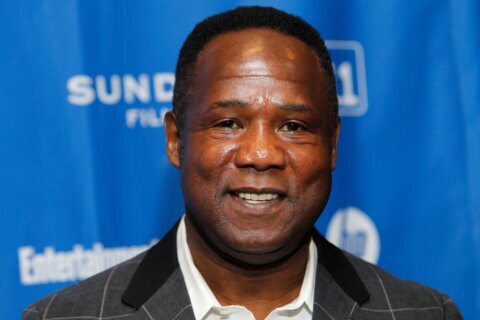From the discos of “Saturday Night Fever” to the drive-ins of “Grease” to the shootouts of “Pulp Fiction,” few movie stars are as iconic as John Travolta.
This Friday, he delivers his newest role in “The Fanatic,” playing an obsessed fan who just wants an autograph from his favorite Hollywood star. When he is stiffed by the celebrity, he takes increasingly creepy actions to get closer to his idol.
“I have a full knowledge of all the characters, especially the fan and the film actor, so I can look at it from all sides,” Travolta told WTOP. “I am a fan by nature. I always had a thing for being excited about watching a good artist, a good athlete, a person who made a difference in the world. I identify with being a fan.”
His goal was to gradually get his character to cross the line, similar to Jake Gyllenhaal’s masterful performance in Dan Gilroy’s “Nightcrawler” (2017).
“He’s just crazy about this movie star that he wants to meet desperately more than anything in the world,” Travolta said. “When the movie star mistreats him, he doesn’t know what to do with it. He’s picked on a lot in life, he’s bullied, so when the person he loves the most in the world, at least in his fantasies, he gets confused. Then he nukes the line of privacy, of a moral code, of ethics.”
It becomes an explosive situation when the celebrity (Devon Sawa) pushes back.
“The movie star is a good person, but he isn’t a good celebrity,” Travolta said. “He has his limits, and he’s not observant of this guy. He isn’t seeing that he’s an unusual guy. He just thinks he’s a stalker-type fan, but he doesn’t realize there’s a little something different about him. He could have solved it easily by just signing the goods. He’s the kind of guy that if the tire is flat, he kicks the cat.”
Travolta makes specific acting choices to play a character that he said is on the spectrum, including rocking back and forth and rarely making eye contact.
“Whenever I look at a character, I say, ‘What is he doing and what do I have to justify in his behavior?'” Travolta said. “It wasn’t just man-child innocent, it was not clocking the seriousness of what he has just done. So, I thought I have to put him a little more advanced on the spectrum to justify that, which I did. When you do that, you can create behavior physically that allows you to understand where he is coming from, so the way he speaks, the way he walks on his toes.”
The entire thing is directed by former Limp Bizkit frontman Fred Durst, who has experience with music videos and several indie films since the band’s heyday.
“One of my favorite parts is the black screen when the sketches fill with color with that classical music underneath it,” Travolta said. “It gives you the haunting ambience, but it also gives you the Marat/Sade, slightly demented perspective. … He was so brilliant at articulating what he wanted and those sketches are one of the interesting parts of his vision, so you knew you were in good hands with him.”
Travolta said his favorite directors possess a strong vision.
“The thing of differentiating great directors from ordinary directors is ask them what their vision is,” Travolta said. “You’ll be amazed by the amount of people who cannot articulate their vision. It’s all about vision. That’s what I never understood. If you’re going to really call yourself an auteur or filmmaker, you must as a criteria. It’s not the writing of a book, it’s the creating of visual imagery.”
Arguably the greatest auteur of his career was Quentin Tarantino during the groundbreaking “Pulp Fiction” (1994), which is celebrating its 25th anniversary.
“He’s unique in that he is a film student [and] has his own wild imagination,” Travolta said. “He has a way of telling a story that is his own original vision. … You don’t know how many times I’m asked, ‘What’s in the black briefcase? What is the Band-Aid on the back of the character’s neck?’ [Robert] Altman was like that too; Altman left a lot to your imagination because it doesn’t really matter what he’s thinking, it matters what you’re thinking. That’s part of his genius.”
He said Tarantino allowed him the freedom to sculpt certain elements of his character, Vincent Vega, from his iconic twist dance with Uma Thurman at Jack Rabbit Slim’s to his “royale with cheese” banter with Samuel L. Jackson.
“Quentin preferred me because he felt that I was perhaps a more unpredictable actor,” Travolta said. “He is up for that ride. A lot of directors aren’t up for that ride. He said, ‘When I hired you to do Vincent Vega, I had no idea how you were going to do it. Then I started to get a sense of how you were going to do it, so I let you go. When you were moving slow, suffing and talking different, I didn’t know exactly what you were doing, then I realized you were playing the heroin. … His genius is really trusting the actor and allowing them to do it how they feel it.”
The role gave an adrenaline shot to Travolta’s career decades after debuting in TV’s “Welcome Back Kotter” (1975). He followed up with a supporting role in Brian DePalma’s “Carrie” (1976) and his leading man breakthrough in John Badham’s “Saturday Night Fever” (1977), earning his first Oscar nomination.
We’ll never forget Travolta’s iconic strut down the street to “Stayin’ Alive” during the opening credits and his disco moves on that light-up dance floor to “You Should Be Dancing,” but did you know it was his idea to swap Bee Gees songs?
“I had a debate with [Robert] Stigwood, who produced it. He wanted me to do my big solo dance to ‘Stayin’ Alive.’ I said, ‘Nah, it’s too slow. But, what I could do is walk down the street in the beginning to that. You can’t do the type of solo I’ve been working on for nine months with that kind of music, but maybe something like ‘You Should Be Dancing,’ I could move to that with a little more speed. But ‘Stayin’ Alive’ song is a strut song.’ He said, ‘Fair enough, if you do the strut down the street to that, I’ll let you do the solo to ‘You Should Be Dancing.’ I did a trade.”
The following year, he starred as the beloved Danny Zucko in “Grease” (1978), earning his second Golden Globe nomination singing such hits as “Greased Lightning” and “You’re the One That I Want.” How did he and Olivia Newton-John come up with the famously high falsetto on the last note of “Summer Nights?”
“In all fairness, it was written into the song,” Travolta said. “I did the Broadway show and road show not as Danny but as Doody, but a classic lick of ’50s songs were those high falsettos. Even Barry Bostwick who originated the role in New York did the falsetto as a reflection of authentic ’50s music. The Four Seasons and other groups that were popular at the time all used that high falsetto.”
Now, Travolta is hoping audiences will follow the instructions of his “Grease” principal. To paraphrase: “If you can’t be a fanatic, be a ‘Fanatic’ supporter.”
Hear our full conversation with John Travolta below:
Hear quick highlights from our conversation below:








